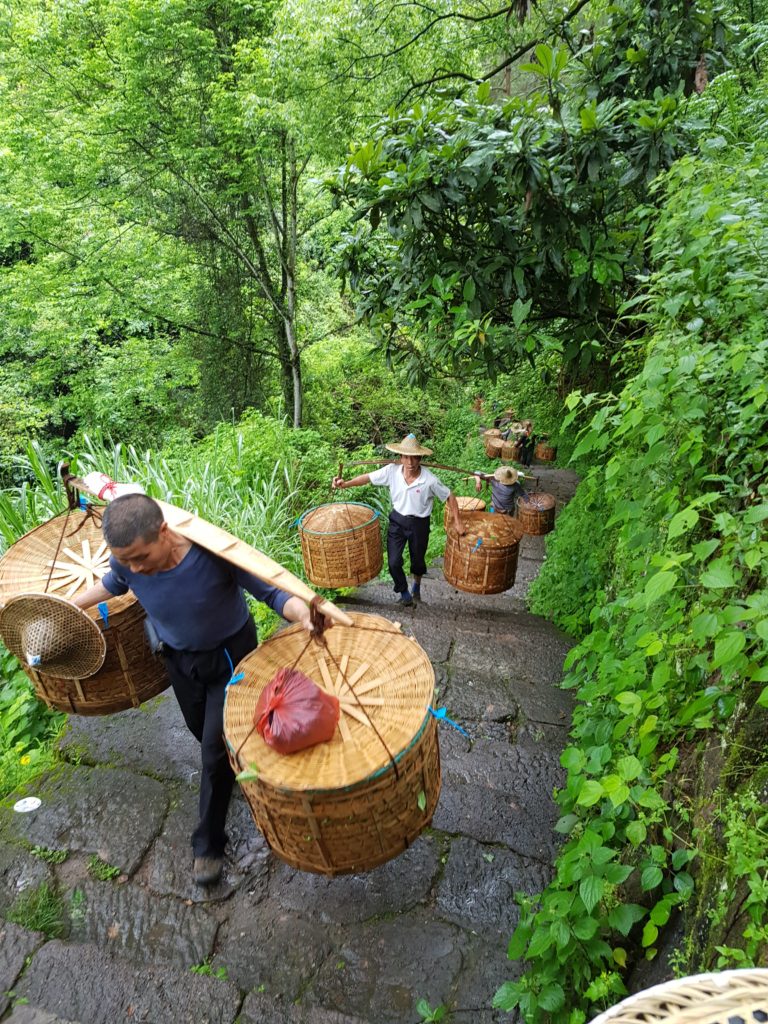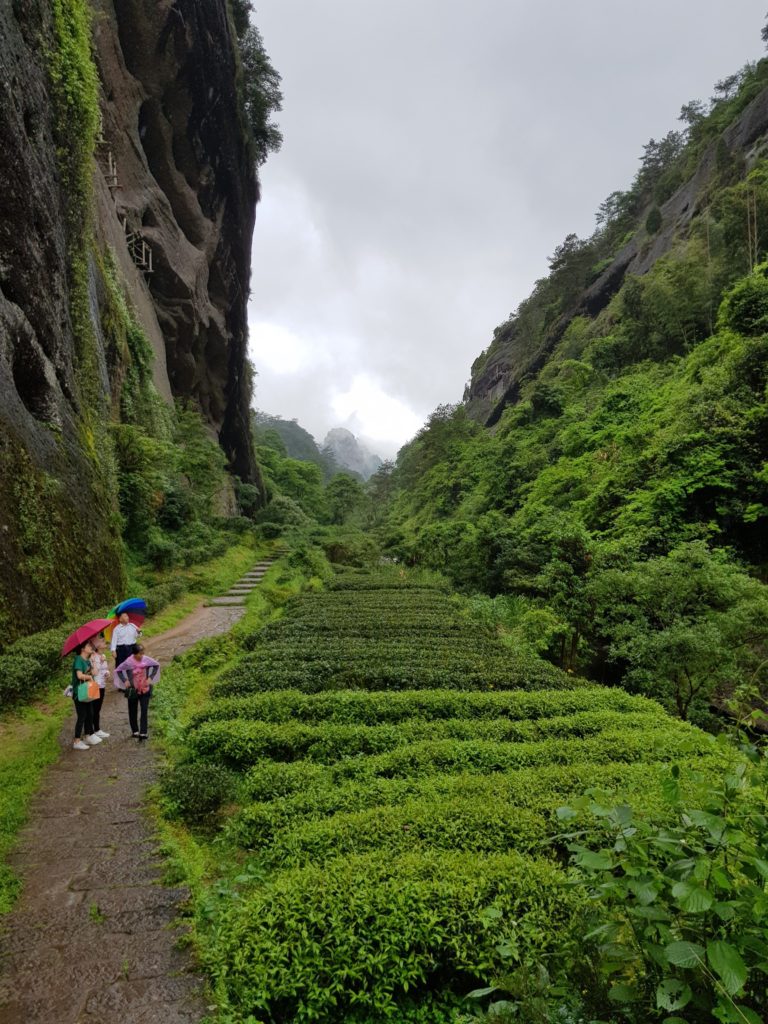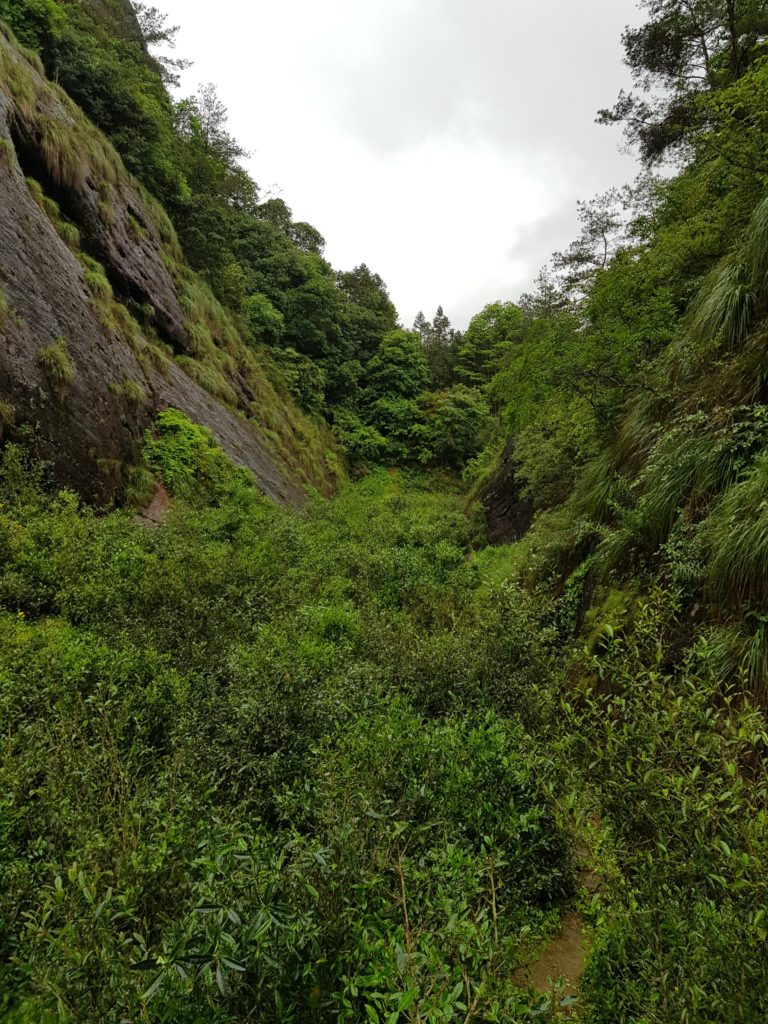
This shot is taken right where we got off our car as we entered the scenic park area – normal cars are not allowed to go in there now, you must take a bus. The only cars allowed in are tea producers’ with the right permit. These are guys whose job it is to haul the raw, freshly plucked leaves from the tea trees inside the scenic area to the waiting cars/trucks, and then hauling them to the factories for processing. Each of the load are 75-100kg. They’re heavy.
These are migrant labourers, mostly from neighbouring Jiangxi province, who get paid something like 200-300 RMB a day to do this work. Sure, the daily wage is fairly high, but it’s back breaking, and it’s only good for a few weeks of the year. For a good amount of the distance they have to travel, it’s on the paved walkway that you see – this was built in the 80s to accommodate tourists coming here. But then, at some point, you have to take a fork and up some dirt path along sometimes fairly steep hill, and then imagine coming back down from the hill with 100kg of tea on your back, in raining condition so that the paths are super slippery. This is not easy work at all.
The path was filled with people doing tea work that day. The teas in this area are all zhengyan, so they’re expensive and worth picking by hand. This means a lot of people are needed, and since everything is done by foot and the distance can be quite long, you need a lot of people very quickly to get things done. There are also some tourists who are just walking through the path, taking in the scenery.

Tea trees are planted all along the path wherever there’s space. Until the 90s, there were a lot of villages inside this park area. People who planted (and still own) these tea trees were all villagers here. Back then, the primary processing areas – basically a shed and a few simple tools – were all very close to the tea planting area. Then the government moved all the villages out of the scenic area for protection of the area itself, because people pollute. So nowadays, the leaves have to be carried way out to get any processing done.
We took a path up a hill towards a plot of trees owned by a tea producer friend. When you walk into this narrow valley, it looks a bit like this

The valley is quite long and narrow, with steep hills on both sides. There’s only one way in and out. There’s a little stream of water flowing in the middle. It’s really ideal ground for tea plants – damp, cool, lots of shade, etc. It’s no wonder the tea here is good. Hiking up the hill to get here takes a bit of effort if you’re not in good shape, and I can’t imagine doing it with 100kg on my back. Many of the trees here are decades old. Prices, of course, match the quality.
One thing that surprised me is that they don’t really care if it’s raining – they’ll harvest anyway. If it’s very early in the season, and the rain is projected to stop very soon after, sometimes they’ll wait, but more often than not they’ll just harvest away – because there’s a lot of tea to harvest, and there just isn’t enough manpower and time to do it all at once. If you wait too long, the leaves get old and then it’s valueless. Since they only harvest once a year, that’s a lot of lost income if you let the leaves go. So, harvest they must, even if the processing is tougher and quality perhaps less than optimal.
We entered the park around 1:30, and didn’t leave till close to 6pm when the sun was setting. All the workers were finishing up as well, waiting for trucks to pick them up to go back, only to come back early the next morning to start again. Even then, I saw a couple workers taking photos of the scenery around them – even though it’s back breaking work, the natural beauty here is impressive and perhaps makes the work just a little more pleasant.

 RSS - Posts
RSS - Posts
5 responses so far ↓
Ricegeek // May 4, 2019 at 11:41 am |
Thanks for sharing your trip! Love learning about little nuggets of details for the harvest. Nice pictures too.
John B // May 4, 2019 at 11:04 pm |
A local Bangkok Chinatown shop owner here has a picture of him standing beside what he described as a family ran tea processing building inside that park area, removed at one point when the park was established, as covered in this post. He’s on the older side now but was quite young in that photo, so it might have been taken around 45 years ago.
zlc // May 8, 2019 at 8:59 pm |
Have a great time there.
Ayumi Anraku // May 12, 2019 at 12:12 am |
Thank you for the instructive post! I always wanted to visit Wuyishan but haven’t had the chance to go there yet, unfortunately. I am very pleased that I can read about both how it was years ago and the current state of this famous tea producing mountain. The tea-carrying work looks hard, indeed!
TM // May 12, 2019 at 5:18 pm |
Hey, 🙂
any tips on how to buy tea in wuyishan?